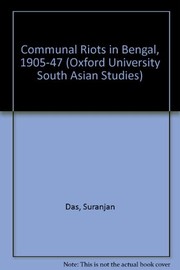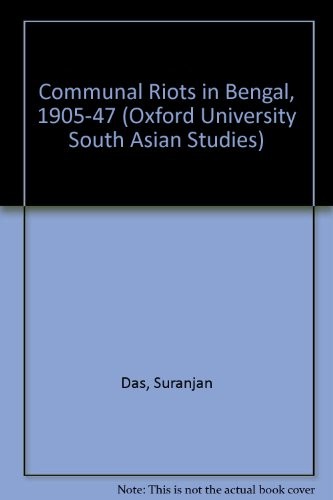Check nearby libraries
Buy this book

This book examines the changing pattern of Hindu-Muslim rioting in Bengal between 1905 and 1947. It has utilized and adapted methods and terminologies employed in contemporary scholarship to investigate a wide range of historical events and processes which are difficult to comprehend when ordinary norms of behaviour prevail.
In examining the major riots in Bengal between 1905 and 1947 the author has addressed the following issues: how an increased conjunction of elite and popular communalism created the necessary background for the riots; why the riots lost their initial class basis and became overtly communal; how a crowd-leadership dichotomy often asserted their 'autonomy'; and finally, how the riots promoted communal consciousness at various levels of society and polity which provided an important backdrop to the partition of the province in 1947. Against the background of the larger political dilemmas confronting India in the pre-partition period, this work has analysed the developing relationships between elite and popular participation in violence, and between the religious and secular features of their mobilization.
Central in this theme is the re-examination of the concepts of community, communalism and community consciousness as they have been applied to the understanding of the evolution of Hindu-Muslim relationships and conflicts in the history of the subcontinent. This research has identified popular perceptions of communal violence and its role in the moral order of the people, the development of new symbols and identities around which these perceptions were organized and the construction of new cultural forms through which these gained public expressions. At the same time it has been emphasized that communalism was not a static phenomenon. It is a moot point as to whether the Bengali peasant or the urban worker was ever solely or even largely motivated by hostility towards his Hindu or Muslim brethren except at brief moments of violence. Nor was there any uniform progress towards separatist politics in Bengal. Until the last moment there were constant oscillations between nationalist and separatist politics: Hindu-Muslim united fronts against imperialism alternating with bouts of internecine fighting. Ultimately, however, mainstream nationalism alienated the predominant section of the politicized Muslims and developed a strong Hindu identity.
This prepared the ground of the truncated settlement of 15 August 1947. The transformation in the shape of communal violence was both an index to and a reflection of the changing political culture in twentieth century-colonial Bengal. This book will provide a better understanding of the phenomenon of communal identity and its popular response in the history of India
Check nearby libraries
Buy this book

Subjects
Riots, Religious life and customs, Social conditions, Communalism, History, Bengal (india), history, Hindus, Muslims, Ethnic relations, Politics and governmentPlaces
India, Bengal (India), BengalTimes
20th centuryShowing 2 featured editions. View all 2 editions?
| Edition | Availability |
|---|---|
|
1
Communal riots in Bengal, 1905-1947
1993, Oxford University Press
in English
0195632338 9780195632330
|
zzzz
Libraries near you:
WorldCat
|
|
2
Communal riots in Bengal, 1905-1947
1991, Oxford University Press
in English
0195628403 9780195628401
|
aaaa
Libraries near you:
WorldCat
|
Book Details
Edition Notes
Includes bibliographical references (p. [290]-304).
Revision of the author's thesis (doctoral--Oxford University, 1987).
Includes index.
Classifications
The Physical Object
ID Numbers
Community Reviews (0)
Feedback?| July 23, 2024 | Edited by MARC Bot | import existing book |
| February 1, 2023 | Edited by ImportBot | import existing book |
| January 17, 2023 | Edited by ImportBot | import existing book |
| February 5, 2010 | Edited by WorkBot | add more information to works |
| December 10, 2009 | Created by WorkBot | add works page |









